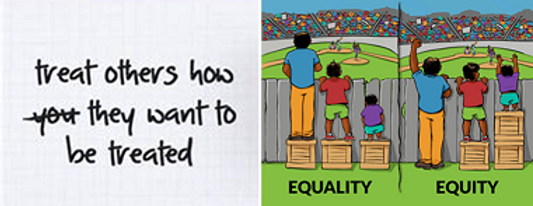
Golden vs Platinum Rule: Equality vs Equity
Do you want to be treated like everyone else or to your specific needs?
We have all heard of the golden rule that asks you to treat others as you’d like to be treated. There is also the platinum rule that suggests you treat others the way they want to be treated. We all have different needs and want to be treated in different ways.
During a previous role, I asked my boss to accommodate a schedule change due to my current situation. His response was “if I do this for you, I need to let everyone on the team start early and go home early as if I do not, it is not fair to give you an “advantage”. I responded by, “how do you know as we are not all in the same position, nor do we have the same needs”. The end result was the typical black and white answer, “no”. I am sure many of us have been in the same position and it is understandable. We want to be “fair” and not feel we are “favoring” others. For me, I want to be treated as my unique, awesome self and have the same opportunities as everyone else. Who’s with me on this one?
First coined by Dave Kerpen, author of The Art of People, the “Platinum Rule” states you should treat others the way they would like to be treated. At first glance this slight change in perspective may seem minor, but it’s actually quite significant.
All people are different, and this should be embraced. The Golden Rule is outdated in that it assumes the way you want to be treated is the way everyone else might want to be treated. In reality, people have different backgrounds, cultures, goals and learning styles that should be acknowledged and embraced. This provoked me to think of equality and equity and how this is similar.
Equality is similar to the golden rule in that we are all the same and as such we should be treated the same. In the image we all get the same “box” to stand on (equal width and height) and as such we do not think there are differences. Equity is similar to the “platinum” rule as it is about acknowledging that as individuals, we have unique needs. In the image, we adjust the “box” so everyone has the same advantages and opportunities to “see things”.
Daria Pritup, Project Manager at Miltton Sparks, points out that the principle of equity is not always welcomed with open arms in the workplace as some groups perceive equity as the opposite of fair. “We have been brought up to think that equality (equal opportunity, the same level of support for everyone) is the key to happiness and success, and so equity (varying levels of support based on needs) feels unfair. To be more comfortable with equity, we must be open to the experience of others and the challenges they face, learn about the way we create culture and culture creates us as well as allow ourselves to feel uncomfortable and grow.”
In the work context, even though equality and equity are often used interchangeably, they are not the same idea. Equality means everyone should be treated equally under the existing culture in your workplace. Equity is knowing that certain members of your staff come to work each day with different requirements that need to be accommodated before they can receive equal treatment.
What can we do as leaders to Enable an Equitable Working Environment?
7 exceptional examples of equity in the workplace
- Make job descriptions accessible. This means having transparency around the wage range for different positions, as well as providing a variety of avenues through which talent may access application materials (including non-web-based channels).
- Skills-based hiring. Not everyone has access to higher education and this shouldn’t barr them from opportunities for work if they have the skills necessary to do the job. Instead of focusing on specific degree requirements in your hiring process, emphasize skills and previous work experience. If you have an existing workforce education program in place, your business has the unique opportunity to provide employees without a degree with the tools and support they need to earn one.
- Provide inclusive incentives. Event-based incentives which center around alcohol or formal dress codes have the potential to alienate some employees. Financial or recognition-based incentives are a better way to reward top-performing team members and avoid exclusion.
- Provide equitable access for all employees. This not only means access to resources and opportunities, but also physical spaces and materials. It is important to consider whether your meeting room is wheelchair-friendly, whether you have accurate closed-captions on a video presentation, and if your office space has adequate accommodations for employees with sensory sensitivities.
- Empower your employees. Even if you have all the best resources in place, it’s up to your employees to take advantage of them. For you, this means making sure your employees know about the resources, know how to access them and feel comfortable and safe doing so.
- Ensure equitable benefits. Spousal health insurance should be available to same-sex couples and non-traditional families as well as straight couples. Additionally, parental leave should extend to fathers and mothers equally.
- Re-evaluate your equity practices. Everyone makes mistakes and as we continue to take action against a problematic status quo it can be difficult to know what’s right. Organizations should continue to analyze and update their equity practices as new information is given.
